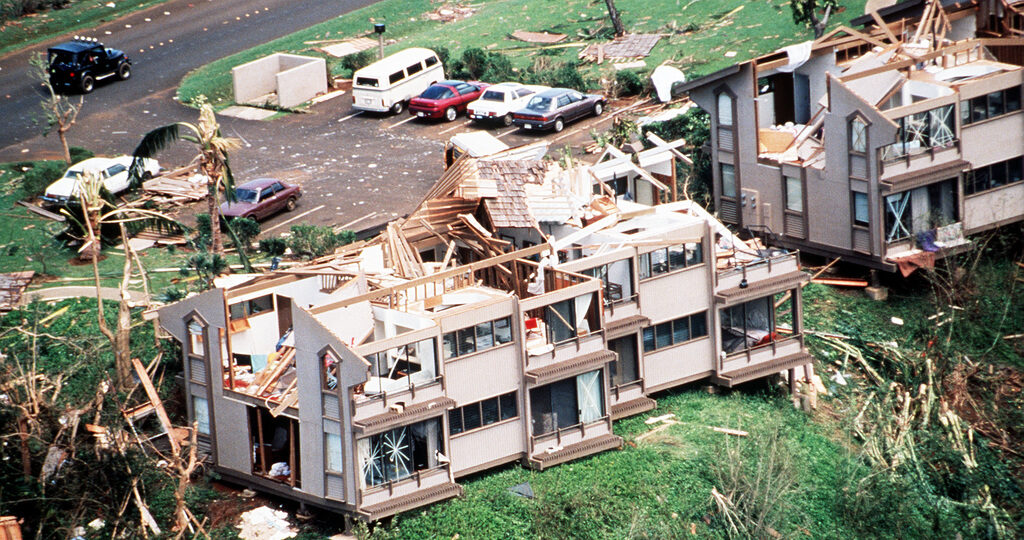


Housing is Key to Recovering from Climate Disasters
01/17/2025

20 years after Hurricane Katrina, natural disasters are creating even more need for housing and emergency planning as climate change fuels homelessness
A note to readers: Fariha Tayyab’s blog post was written in the final months of 2024 before tens of thousands of Los Angeles residents lost their homes in wildfires. With each new disaster, the main argument of her piece grows more urgent.
2024’s record-breaking and destructive hurricane season brought back memories of August 2007, when our city supported Hurricane Katrina survivors displaced from New Orleans. I volunteered at the George R. Brown Convention Center where lines of double-sized air mattresses filled the family section, looking like a Lego project waiting for people. A year after Hurricane Katrina, only 53% of New Orleans adults had returned and only one third of those residents returned to the home they lived in before the storm.
The 2024 Hurricane season hit new records, extending both into the spring and fall seasons, causing significant damage and bringing back-to-back hurricanes to the southeast. This included Hurricane Helene – the deadliest mainland hurricane since Hurricane Katrina.
We can only wonder what extreme weather we will face in 2025. A warming climate, including rising sea surface temperatures, rapid wind speed and increased rainfall will intensify these climate disasters, pushing hundreds of thousands of people out of their homes, either temporarily or permanently.
Many people already struggle with housing they can’t afford. This is often made worse when paired with housing that’s far from good-paying jobs, uncertainty from renting with lax legal protections or living with fewer housing options because of a disability.
As we prepare for the 2025 storm season, we should consider how climate disasters will affect the ability of people to get and stay housed. The more unstable our housing system and protections are before the storm, the more difficult it will be to ensure housing stability for survivors after the storm. Some with already unstable housing will be immediately displaced from the region, while others will appeal to FEMA and other support to repair their damaged homes. Those who already live in temporary shelters like vans or tent encampments may face dangerous conditions through and after storms such as wind, falling trees and rising waters.
Some key considerations that organizations who work with people who experience homelessness, public officials who are doing disaster planning and everyday advocates should consider include:
- When households are immediately displaced by a climate disaster, what options are available to provide short-term housing quickly?
- What networks and communications systems exist to provide rapid outreach and safety planning with people living outside or in their vehicles so they can shelter safely from the storm?
- What resources are available to mitigate the short- and long-term loss of income when job sites are destroyed or people cannot return to work because they must rebuild their homes?
- What community support and health resources are available to respond to grief, persistent depression, anxiety and even post-traumatic stress disorder that comes from enduring disaster and losing your home?
- What lessons have already been learned by service providers for people experiencing homelessness and organizations that build affordable housing, which can help government leaders plan for and create meaningful community responses?
Each disaster significantly impacts our neighbors’ ability to obtain short- and long-term housing, especially as the cost of repair, insurance and goods continues to rise due to global warming.
The increasing cost of housing and the rising number of climate disasters in this era of climate emergency continue to affect us on a daily basis. We cannot separate the two. As we plan for the ongoing climate crisis, expanding access to affordable housing and emergency support services for those who are unhoused now, and those who are likely to become homeless from disasters, must be a key part of our plans.
________________________________________________________
Fariha Tayyab is a multidisciplinary artist hailing from Houston. As a writer and photographer, her work explores identity, radical reimagination and liberation work. Her publications, interviews and other storytelling work can be found at www.farihatayyab.com

1828 L St. NW
Suite 300
Washington, DC 20036
© Copyright 2025 Privacy Policy